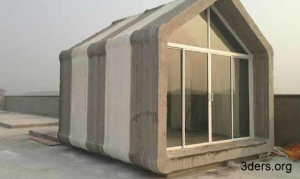There has been a tremendous amount of excitement around the 3D printing of homes. New large scale 3D printers which use a concrete material instead of plastics or resins, are being heavily  researched in both China and the United States. In the meantime, architects in Amsterdam are constructing the first ever 3D printed plastic homes. The actual technology is still in its infancy, but something incredible was revealed last week by WinSun Decoration Design Engineering Co, out of China.
researched in both China and the United States. In the meantime, architects in Amsterdam are constructing the first ever 3D printed plastic homes. The actual technology is still in its infancy, but something incredible was revealed last week by WinSun Decoration Design Engineering Co, out of China.
The Chinese company revealed photo’s to 3ders.org, of several concrete homes which they claim to have 3D printed. The process included the recycling of old construction materials into a moist concrete material which was then extruded from an enormous 3D printer with measurements of 490 X 33 X 20 feet. The homes are printed in pieces at the WinSun factories, and then transferred to their final location where they are assembled by a construction crew.
These homes are selling for as little as $4,800 in China. Just imagine how much further prices may drop as competition between China and the United States heats up within the large scale 3D printing market.
According to the U.S. Department of Housing and Urban Development, in the United States we currently have approximately 600,000 people living on the streets, homeless. Homelessness is probably the biggest socioeconomic issue in this country today, and has been for decades. A solution to this problem would easily rank as one of the most, if not the most, significant accomplishments of society this country has ever witnessed.
You would think such a major issue would be impossible to ever fix. It would cost too much money, right? Not so fast! Did you know that the United States last year spent over $220 billion ($220,000,000,000.00) making interest payments on our national debt? What if we could 3D print a home for every single homeless person in the United States? Let’s assume that the Chinese are  underestimating what it would cost in the United States to print similar homes. Instead of $4,800 per home, let’s make it $10,000. Now add in another $5,000 for the land needed to construct these homes, and you have a total of $15,000 per house. Multiply $15,000 by the 600,000 homeless Americans, and you get a figure astoundingly low; $9 billion.
underestimating what it would cost in the United States to print similar homes. Instead of $4,800 per home, let’s make it $10,000. Now add in another $5,000 for the land needed to construct these homes, and you have a total of $15,000 per house. Multiply $15,000 by the 600,000 homeless Americans, and you get a figure astoundingly low; $9 billion.
Yes, for just over 4% of the total interest payments we are making annually to the bond holders of our national debt, we could construct homes for every single homeless person in this great nation. Another way to look at this, is that the interest we pay on out national debt every 15 days could be used to construct 3D printed, concrete homes for all the homeless in this country. Why is this not happening today? Engage in a discussion about this very idea at 3DPrintBoard.
Subscribe to Our Email Newsletter
Stay up-to-date on all the latest news from the 3D printing industry and receive information and offers from third party vendors.
You May Also Like
Gorilla Sports GE’s First 3D Printed Titanium Cast
How do you help a gorilla with a broken arm? Sounds like the start of a bad joke a zookeeper might tell, but it’s an actual dilemma recently faced by...
Nylon 3D Printed Parts Made More Functional with Coatings & Colors
Parts 3D printed from polyamide (PA, Nylon) 12 using powder bed fusion (PBF) are a mainstay in the additive manufacturing (AM) industry. While post-finishing processes have improved the porosity of...
$25M to Back Sintavia’s Largest Expansion of Metal 3D Printing Capacity Since 2019
Sintavia, the digital manufacturing company specializing in mission-critical parts for strategic sectors, announced a $25 million investment to increase its production capacity, the largest expansion to its operations since 2019....
Velo3D Initiates Public Offering in a Bid to Strengthen Financial Foundations and Drive Future Growth
Velo3D (NYSE: VLD) has been among a number of publicly traded 3D printing firms that have attempted to weather the current macroeconomic climate. After posting a challenging financial report for 2023,...































